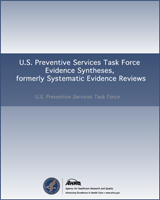NCBI Bookshelf. A service of the National Library of Medicine, National Institutes of Health.
Jonas DE, Reuland DS, Reddy SM, et al. Screening for Lung Cancer With Low-Dose Computed Tomography: An Evidence Review for the U.S. Preventive Services Task Force [Internet]. Rockville (MD): Agency for Healthcare Research and Quality (US); 2021 Mar. (Evidence Synthesis, No. 198.)

Screening for Lung Cancer With Low-Dose Computed Tomography: An Evidence Review for the U.S. Preventive Services Task Force [Internet].
Show detailsFigure 3Trial results for lung cancer incidence (KQ 1)
Note: G1=LDCT; G2=Control; Favors Intervention indicates fewer incident lung cancers with intervention (LDCT screening); Favors Control indicates more incident lung cancers with intervention. Two rows are included in the figure for the NLST, showing the data from the 6.5-year followup and from the extended post-screening followup data at a median of 11.3 years after randomization for lung cancer incidence. The NELSON trial reported lung cancer incidence for the 13,195 males enrolled in the trial, excluding the 2,594 females that were enrolled. Therefore, the NELSON results in the figure above include only data for male participants (data were not reported for the female participants). The trial did not report total person-years of followup for lung cancer incidence, but those were able to be calculated from other data that were reported (5.58 cases per 1,000 person-years vs. 4.91 cases per 1,000 person-years at 10 years; RR, 1.14 [95% CI, 0.97, 1.33]). The Nelson trial reported median age and median pack-years instead of mean age and mean pack years. The LUSI trial was not included in the figure above because it did not reporting person-years of followup. The LUSI trial reported 85 lung cancers in the intervention group and 67 in the control group at a mean of 8.8 years follow up (p=0.16).
Abbreviations: DANTE=Detection and Screening of Early Lung Cancer with Novel Imaging Technology and Molecular Essays; DLCST=Danish Lung Cancer Screening Trial; ITALUNG=Italian Lung Cancer Screening Trial; LUSI=Lung cancer Screening Intervention; NELSON=Nederlands-Leuvens Longkanker Screenings Onderzoek; NLST=National Lung Screening Trial.
- Figure 3, Trial results for lung cancer incidence (KQ 1) - Screening for Lung Ca...Figure 3, Trial results for lung cancer incidence (KQ 1) - Screening for Lung Cancer With Low-Dose Computed Tomography: An Evidence Review for the U.S. Preventive Services Task Force
Your browsing activity is empty.
Activity recording is turned off.
See more...
![Click on image to zoom Figure 3 displays a forest plot reporting the trial results for lung cancer incidence (KQ1). The figure includes trials that compared LDCT screening to control. For the NLST trial the figure displays the data for 6.5 years and 11.3 years of follow up. At 6.5 years, the NLST trial reported a higher incidence of lung cancer in the intervention group compared to control (1,089 vs. 969 events; RR, 1.12 [95% CI, 1.02 to 1.22]). At 11.3 years of follow up, the NLST trial reported a higher incidence of lung cancer in the intervention group compared to control (1,701 vs. 1,681 events; RR, 1.01 [95% CI, 0.95 to 1.08]). For the DANTE trial, a higher incidence of lung cancer was reported in the intervention group compared to control (106 vs. 73 events; RR, 1.35 [95% CI, 1.00 to 1.81]). For the DLCST trial, a higher incidence of lung cancer was reported in the intervention group compared to control (100 vs. 53 events; RR, 1.89 [95% CI, 1.36 to 2.64]). For the ITALUNG trial, a higher incidence of lung cancer was reported in the control group compared to the intervention group (71 vs. 67 events; RR, 0.92 [95% CI, 0.66 to 1.28]). For the NELSON trial, a higher incidence of lung cancer was reported in the intervention group compared to control (341 vs. 304 events; RR, 1.14 [95% CI, 0.97 to 1.33]).](/books/NBK568578/bin/ch3f2.jpg)